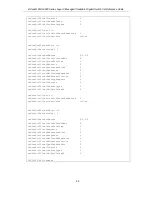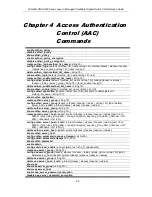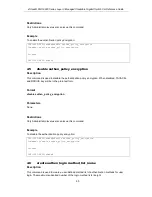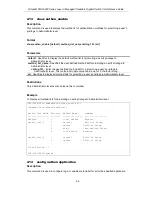
xStack® DGS-3620 Series Layer 3 Managed Stackable Gigabit Switch CLI Reference Guide
57
The Switch also supports the RADIUS protocol for authentication using the Access Authentication
Control commands. RADIUS or Remote Authentication Dial In User Server also uses a remote
server for authentication and can be responsible for receiving user connection requests,
authenticating the user and returning all configuration information necessary for the client to deliver
service through the user. RADIUS may be facilitated on this Switch using the commands listed in
this section.
In order for the TACACS / XTACACS / / RADIUS security function to work properly, a
TACACS / XTACACS / / RADIUS server must be configured on a device other than the
Switch, called a server host and it must include usernames and passwords for authentication.
When the user is prompted by the Switch to enter usernames and passwords for authentication,
the Switch contacts the TACACS / XTACACS / / RADIUS server to verify, and the
server will respond with one of three messages:
The server verifies the username and password, and the user is granted normal user privileges on
the Switch. The server will not accept the username and password and the user is denied access
to the Switch.
The server doesn’t respond to the verification query. At this point, the Switch receives the timeout
from the server and then moves to the next method of verification configured in the method list.
The Switch has four built-in server groups, one for each of the TACACS, XTACACS,
and RADIUS protocols. These built-in server groups are used to authenticate users trying to
access the Switch. The users will set server hosts in a preferable order in the built-in server group
and when a user tries to gain access to the Switch, the Switch will ask the first server host for
authentication. If no authentication is made, the second server host in the list will be queried, and
so on. The built-in server group can only have hosts that are running the specified protocol. For
example, the TACACS server group can only have TACACS server hosts.
The administrator for the Switch may set up five different authentication techniques per user-
defined method list (TACACS / XTACACS / / RADIUS / local / none) for authentication.
These techniques will be listed in an order preferable, and defined by the user for normal user
authentication on the Switch, and may contain up to eight authentication techniques. When a user
attempts to access the Switch, the Switch will select the first technique listed for authentication. If
the first technique goes through its server hosts and no authentication is returned, the Switch will
then go to the next technique listed in the server group for authentication, until the authentication
has been verified or denied, or the list is exhausted.
Note:
User granted access to the Switch will be granted normal user privileges on the
Switch. To gain access to admin level privileges, the user must enter the enable
admin command and then enter a password, which was previously configured by
the administrator of the Switch.
Note:
TACACS, XTACACS and are separate entities and are not compatible.
The Switch and the server must be configured exactly the same, using the same
protocol. (For example, if the Switch is set up for TACACS authentication, so must
be the host server.)
4-1
enable authen_policy
Description
This command is used to enable system access authentication policy. When enabled, the device
will adopt the login authentication method list to authenticate the user for login, and adopt the
Summary of Contents for xStack
Page 1: ......
Page 553: ...xStack DGS 3620 Series Layer 3 Managed Stackable Gigabit Switch CLI Reference Guide 548 ...
Page 565: ...xStack DGS 3620 Series Layer 3 Managed Stackable Gigabit Switch CLI Reference Guide 560 ...
Page 1011: ...xStack DGS 3620 Series Layer 3 Managed Stackable Gigabit Switch CLI Reference Guide 1006 ...
Page 1120: ...xStack DGS 3620 Series Layer 3 Managed Stackable Gigabit Switch CLI Reference Guide 1115 ...
















































